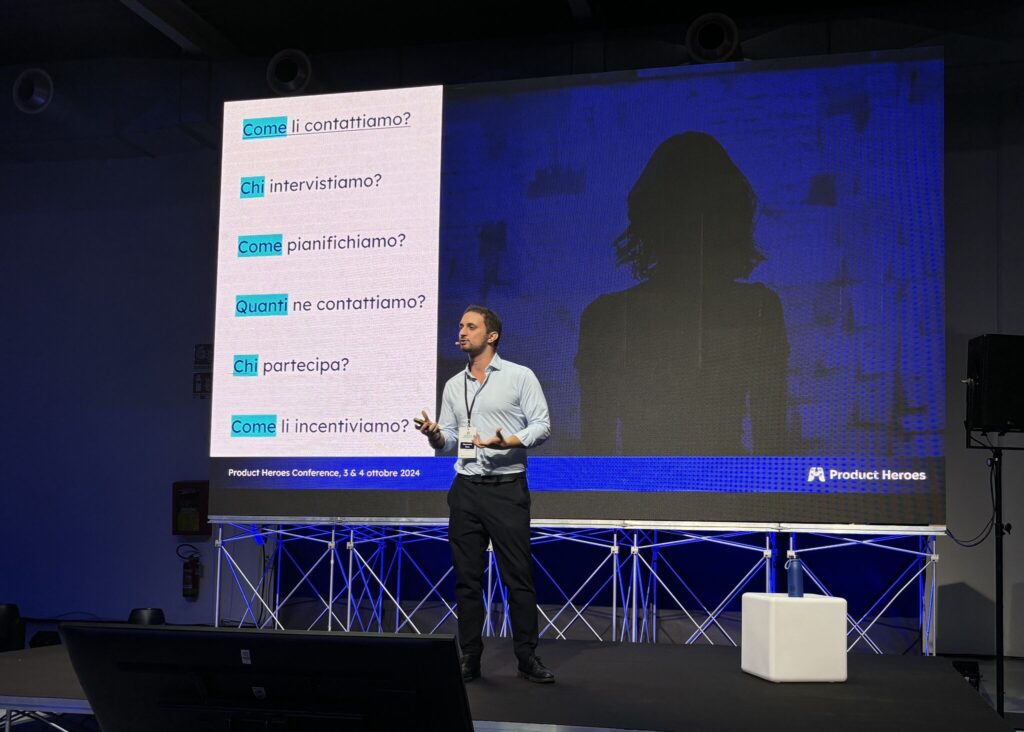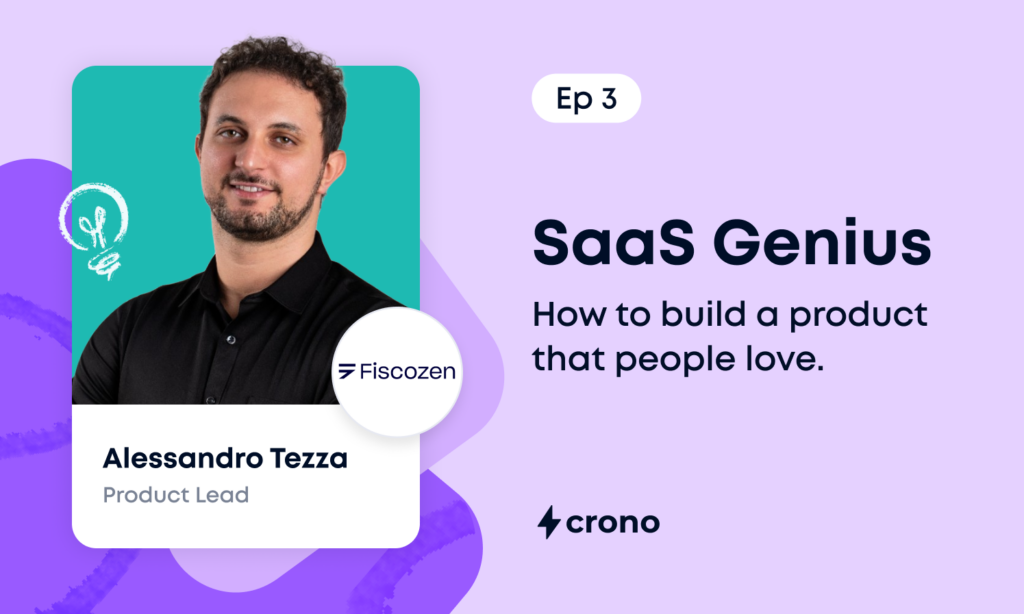Hey there Croners! Here’s a brand new column covering SaaS Products, and more specifically, how to build a product that people love.
Everyone, at some point in their lives, has had an incredible idea: but how does that turn into a product? We’ve asked some experts in design and product development and founders to bring their own experience and knowledge to you.
In this episode, we have Alessandro Tezza, talented Product Lead at Fiscozen.
SaaS Genius: Alessandro Tezza
Hey Alessandro! Let’s start with a quick warm-up: 5 words to describe yourself and 1 tool you can't live without.
I’d describe myself as:
- Optimistic: I always maintain a positive outlook and don’t get discouraged by things that aren’t working as intended. My motto is: “If a year from now you will have forgotten this episode, then it doesn’t make sense to feel bad about it right now.”
- Ambitious: I set high goals and constantly strive to achieve more. This ambition drives me forward, pushing me to improve continuously. However, I should take more moments to appreciate the present and celebrate achievements, both big and small. I believe that balancing ambition with mindfulness is key to staying motivated in the long run.
- Empathetic: I make a conscious effort to understand others and to share my own experiences, which has helped me create meaningful connections with my colleagues. I believe this is critical to successfully working in a team.
- Outspoken: This is both my greatest strength and my soft spot. I am not afraid to voice my opinions and stand up for what I believe in, ensuring my perspectives and ideas are heard. This trait is extremely powerful in advocating for necessary changes and driving innovation. However, I need to manage this aspect, as I know it can sometimes come across as intimidating.
- Overthinker: I am thorough and considerate when making decisions in all aspects of my life, which isn’t always the most efficient approach to decision-making. While it helps me carefully weigh all options and consider potential outcomes before acting, it’s important to understand when to take action to avoid overanalyzing and generating potential delays.
Saying that I cannot live without ChatGPT might be a bit of a stretch since it’s pretty recent. However, it’s the tool I’m using the most and would least want to lose right now. I’ve started to see ChatGPT as a life buddy: I’m continuously interacting with it for both personal and professional matters. The range of topics it can help me with is just incredible.
Can you give us a short overview of your career so far?
After completing my university studies in Computer Science at the University of Padua (Italy), I began my career with a brief experience as a Software Engineer at CyBrain, a B2B cybersecurity company. At CyBrain, I had the opportunity to build a security system for banks designed to identify a specific type of man-in-the-middle attack. This role was instrumental in consolidating my technical skills and provided me with a solid foundation in software development.
In 2018, I joined Contentwise, a B2B company that specializes in UX personalization for video streaming providers, primarily through recommendations and search functionalities. I started as a Professional Services Engineer, where my primary responsibility was to assist our customers in integrating and adopting our solutions.
Additionally, I consulted with them to ensure they could effectively achieve their business goals using our products. It was during this period that I first encountered Product Managers and became deeply fascinated by the nature of the role.
Driven by this newfound interest, I dedicated myself to studying the theory of Product Management. I immersed myself in learning about various frameworks, methodologies, and best practices. My efforts paid off when I eventually got the opportunity to transition into a Product Manager role within Contentwise. I was responsible for developing a new product from the ground up, working closely with a team of engineers and designers.
In 2022, seeking to gain experience in the B2C sector, I joined Fiscozen, a B2C Tax Advisory SaaS for sole traders. Initially, I took on the role of Product Manager, where I worked with both the tech and design teams on an initiative that transformed our internal operational model.
Six months later, I was promoted to Product Lead, the role I currently hold.

As a Product Lead at Fiscozen, I am responsible for the growth product area, managing a team of three Product Managers. My responsibilities include hiring and mentoring my team, defining the product strategy, and organizing our efforts in collaboration with the Head of Product.
What’s the most exciting part of your job as a Product Lead?
I love mentoring my team.
When I was younger, I aspired to be a university professor. The idea of sharing my knowledge with others has always appealed to me, and seeing real improvements in the people I work with is my greatest satisfaction.

I believe a part of me still wants to be a professor, and coaching my team allows me to fulfil that desire in a meaningful way.
Mentoring, however, is distinct from traditional teaching.
When you mentor someone, you focus on creating a personalized development path tailored to the individual’s strengths and areas for growth. This often involves working together to acquire new skills or tackle challenges that are unfamiliar to both of us.
One of the most exciting aspects of my job is the opportunity to engage in this collaborative learning process.
Whether it’s exploring new technologies, developing a strategic approach, or solving a complex problem, mutual growth and shared achievements are incredibly rewarding. By mentoring, I not only contribute to my team members’ professional development but also continue to grow and evolve in my own career.
How does an idea become an innovative SaaS product today?
An idea becomes a successful product when you’re able to perfectly align several key factors, which ultimately comes down to finding the market you’re truly solving a problem for and tuning your idea into a business model that allows you to monetize the value you generate for the market.
For SaaS products in particular, the way you deliver your value and the way you price the product are crucial.
You can play a lot with these two elements: for instance, you can have a subscription-based pricing model or price by consumption. You can organize your pricing into different tiers and experiment with product-led growth approaches to optimize your conversions. The flexibility of SaaS allows for continuous iteration and experimentation, enabling you to fine-tune your product-market fit and maximize customer satisfaction.
Since you’re asking about innovative SaaS products, let me delve a bit more into the concept of innovation. Real innovation is not necessarily about new and trending technologies.
While technologies like generative AI can certainly be a part of innovative solutions, true innovation lies in solving a problem with a completely new approach. This approach should fundamentally change the way people address that problem from that moment on.
Innovation at its best disrupts the competitive landscape: what was true before is no longer applicable.
For instance, I believe that Fiscozen is an innovative SaaS product. It’s not based on the latest trend in technology, but it addresses a long-standing problem in Italy – dealing with tax bureaucracy – by offering a digitalized and highly automated service to its users.
What are the key elements a product can’t miss in order to be loved by its users?
First and foremost, the product must solve a real problem for the customer it is targeting, which means achieving product/market fit. Taking that for granted, I think a product must have three key elements to be loved by its users.
First, it must have an excellent user experience (UX).
Providing an easy and seamless experience is no longer a nice-to-have, even in B2B and internal products. Not only that: for a product to be great, it must have a delightful UX.
This means ensuring that performing tasks is not only easy but also enjoyable. A great way to achieve this is by making proper use of gamification.
I recommend reading “Actionable Gamification” by Yu-Kai Chou, an insightful work that highlights how gamification is not just about adding points and badges everywhere but is a great tool to leverage users’ psychology and motivation to create next-level user experiences.

Second, it’s important that the product has a clear, well-thought-out AHA moment.
The AHA moment is when the product truly resonates with the user, making them realize the value of the product.
The product should be designed in such a way that this realization happens at the perfect time in the user’s journey, ensuring stickiness to the product. This is extremely important in SaaS, where products are often easily accessible but also easy to leave.
Your product might have tremendous value, but it is worth nothing if users churn before realizing it. Last week, I was talking with a friend who is working on a mobile application that uses AI to edit pictures. When he showed me the result of a quick edit, I was amazed: with one click, he edited one of my pictures, and the results were outstanding.
The problem is that users, according to product analytics, did not understand how to make that single click, and they were churning before reaching the aha moment!
Finally, customer support is key.
By this, I mean a broad definition of customer support, including every resource that helps users overcome obstacles in their journey.
This can include support operators, user guides, FAQs, communities, etc.
How we manage users’ problems and difficulties with the product can dramatically change their perception of it.
What would you suggest to someone willing to work in Product?
Landing the first Product Manager role is not easy, unfortunately. Most companies only hire Product Managers with at least three years of experience, making it difficult for aspiring Product Managers to start. However, there are several strategies you can employ to increase your chances.
First of all, focus on theory. There are many resources, especially books, that can help you learn the most important concepts in product management. Studying alone is not enough to land a PM role, but in my opinion, it’s a mandatory requirement. Understanding the theoretical foundation will give you the vocabulary and framework needed to discuss product management principles confidently.
The reality, however, is different from books.
A great way to gain hands-on experience is by working on personal projects. Try to build stuff: collaborate with a developer or experiment with low-code tools, build your first products, and try to monetize them.
This practical experience will help you learn new tools and understand what building products are really like. Moreover, it will provide you with tangible examples to discuss in interviews and demonstrate your initiative and problem-solving abilities.
Networking is another critical aspect. Engage with the product management community by attending meetups, webinars, and conferences.
Leverage LinkedIn to connect with product people. Networking can provide valuable insights, mentorship opportunities, and potential job leads.
Then, I think the best shot someone has to land a role in product management is by transitioning roles within a company.
For instance, you could start as a Customer Success Consultant in a B2B company and then work your way into Product Management. This is a good path because, as a Customer Success Consultant, you get to know your customers really well, which is key to working as a Product Manager.
Other interesting roles to start with before transitioning into Product Management include Software Engineer, Project Manager, or Data Analyst. These roles provide different perspectives and skills that are valuable in product management, such as understanding customer needs, managing projects, and analyzing data.
Any book/resource you’d suggest?
Sure, being an avid reader, I love suggesting product books. Here are four foundational books that lay down the basics of the role and are must-reads for anyone wanting to explore product management (in reading order):
- The Product Book by Carlos González de Villaumbrosia and Josh Anon: it offers a gentle introduction to what a product manager is, their responsibilities, and some basic notions about the role. It’s perfect for those just starting to understand the field and provides a solid foundation.
- The Lean Product Playbook by Dan Olsen: it is a comprehensive guide covering many fundamental concepts of product management. It walks you through lean methodologies and offers practical advice on building successful products. It helps in understanding how to validate ideas and develop products that meet market needs.
- Inspired by Marty Cagan: it lays down the building blocks you need to think like a great product manager. It explores the best practices of leading product teams and emphasizes the importance of building products that customers love.
- Continuous Discovery Habits by Teresa Torres: it focuses on product discovery and it teaches you how to continuously gather insights from users, which is crucial for creating products that truly meet their needs. It also lays down an incredible framework to think about your ideas, the Opportunity Solutions Tree.
While these books provide a strong foundation, there are many other resources that delve deeper into specific topics such as user experience, data analytics, and agile methodologies.
Feel free to reach out to me on LinkedIn for more tailored book recommendations, or even just for a chat!
Ok, final question. What are the challenges of the past, present and future in building a product?
There are many challenges when building products, and I think that’s what makes being a product manager so fascinating: every initiative you work on introduces a new set of challenges and opportunities for learning and growth.
However, I would like to focus this answer on a specific challenge that I believe is of utmost importance in the past, present, and future: access to user data.

In the past, especially before the rise of SaaS, gathering user data was limited due to the lack of appropriate tools, the absence of real-time data, and the high costs associated with data collection. T
his meant that product teams often had to make decisions based on incomplete or outdated information. Products were often built and launched with only limited insights into how users would actually interact with them, which could lead to significant revisions post-launch.
As technology evolved, user data began to be collected more widely, especially with the rise of social media and digital platforms. This transformation brought about a new era in product management. Digital analytics and the increased availability of data fundamentally changed how we build products, enabling faster iterations and providing more quantitative insights to guide decisions.
This shift allowed product managers to make more informed decisions, reduce risks, and better align their products with market demands.
With time, privacy and security became central themes in product management.
The widespread access to user data, while beneficial, led to increasing concerns about privacy. Users began to demand greater transparency and control over their data, and governments around the world responded with stricter regulations, such as GDPR in Europe.
Today, a significant challenge in product management is building products that are both ethical and compliant with these laws. Balancing the need for data to improve products with the imperative to protect user privacy has become a complex task that requires careful consideration and innovative solutions.
Looking to the future, I believe privacy and security will become even more prominent in product development.
The advent of AI will enable a new wave of products that interact with users in entirely new ways, often in ways that are difficult to supervise.
This will pose a significant challenge for future product management: combining the potential of AI with the necessity of regulating how we use user data. As AI systems become more autonomous and capable of making decisions based on vast amounts of data, ensuring that these systems respect privacy, maintain security, and operate ethically will be crucial.
